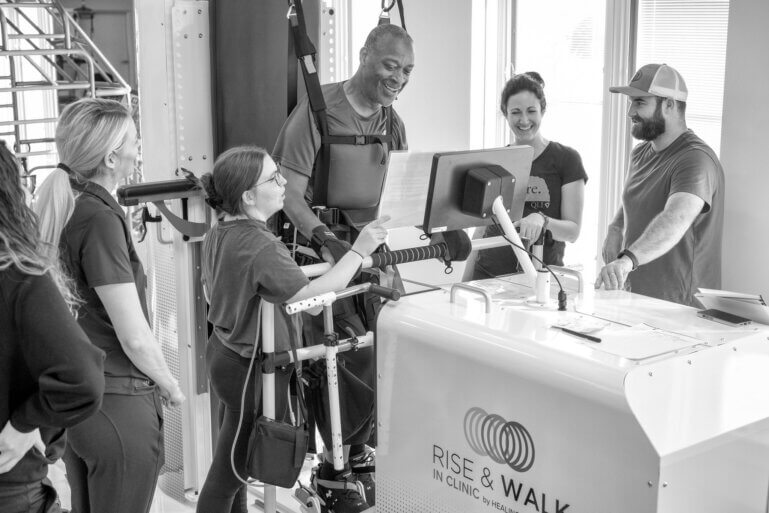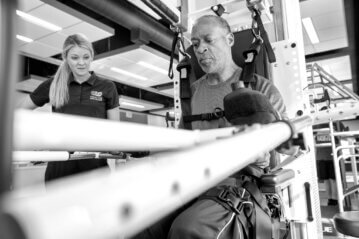Through the pushing of technology, gait training is still at the crux of injury recovery. QLI has heavily utilized devices and equipment such as Eksobionic’s Exoskeleton and the ZeroG harness system. Each is foundational for clients’ reacquisition of the patterns of gait training. However, though these pieces of equipment are crucial and necessary, technology has continued to develop, thus allowing for new technologies such as the Rise&Walk® from Healing Innovations.
The Rise&Walk® acts as a three-in-one device, providing gait training support in three modes—static 
“Improved gait mechanics and the ability to increase intensity throughout a session,” notes Coordinator of Physical Therapy/Occupational Therapy Services Megan Potter, are at the core of what will make the Rise&Walk® a vital part of many clients’ programs at QLI.
The sitting mode provides an opportunity for clients to rework the rhythms of limb motion. Think of a cross between elliptical foot pedals for the feet and ski poles for the hands. With or without applied resistance from these components, speed can be increased, gradually introducing the patterns of movement to a client and inherently building the rhythms, routines, and capabilities of active muscles.
Placing a client in the device is also simple. One transfer to get strapped into the harness and another transfer into the device, followed by the securing of straps to the feet and hands (as necessary) helps the client remain stable while in the device. The harness allows for body-weight support. Other key aspects of variability include the seat height (which in turn alters the positioning of the client’s hips and knees) and the orientation of the hand grips, shifting the level of upper extremity support and length of arm movement.
The gait/walking mode is supplemented by a bar that can rise parallel with a client’s waist, with further positioning provided to align the hands on the bar. As with the sitting mode, controls adjust for the level of assistance the device provides as well as the speed of the machine. “There is great variability in how we as clinicians can control the length of a stride and the speed in the walking mode,” says Megan. “The step, while fixed in its parameters, is essential for neuroplasticity.” Additionally, the static standing mode
Ultimately, the Rise&Walk® provides an ease of access and consistency that ensures making the most of a client’s physical therapy session. For example, if a client is in the walking mode and starts to feel lightheaded, a simple transition can be made to engage the seated mode. The multi-modality options provided by Rise&Walk® extend its use to a wide variety of clients and activities.
Get more information on QLI’s rehabilitation programs.
Categories: Gait Training, Physical Therapy, Rehabilitation, Spinal Cord Injury
